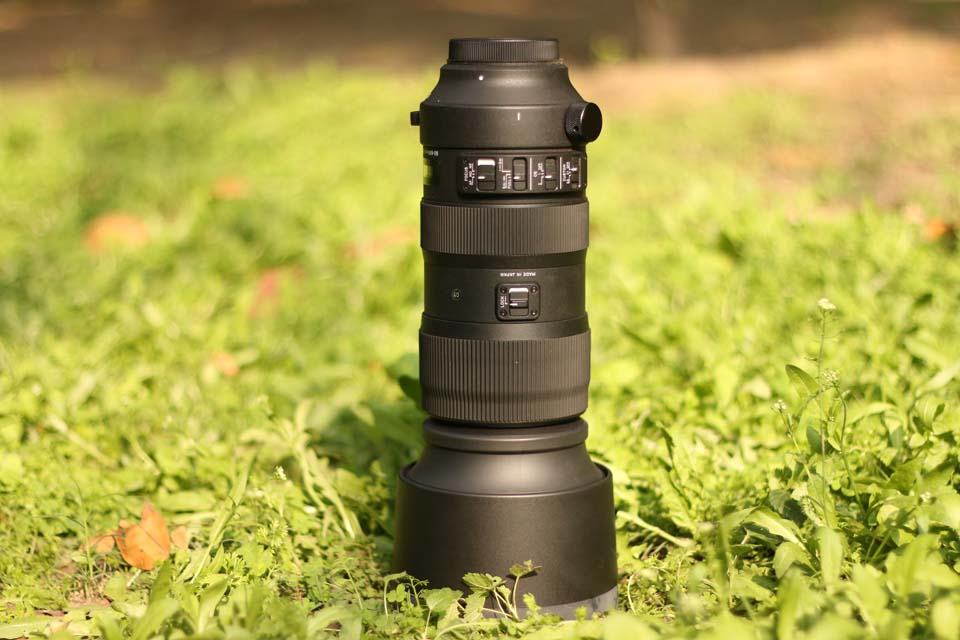Introduction – Sigma 60-600mm f/4.5-6.3 DG OS HSM Review
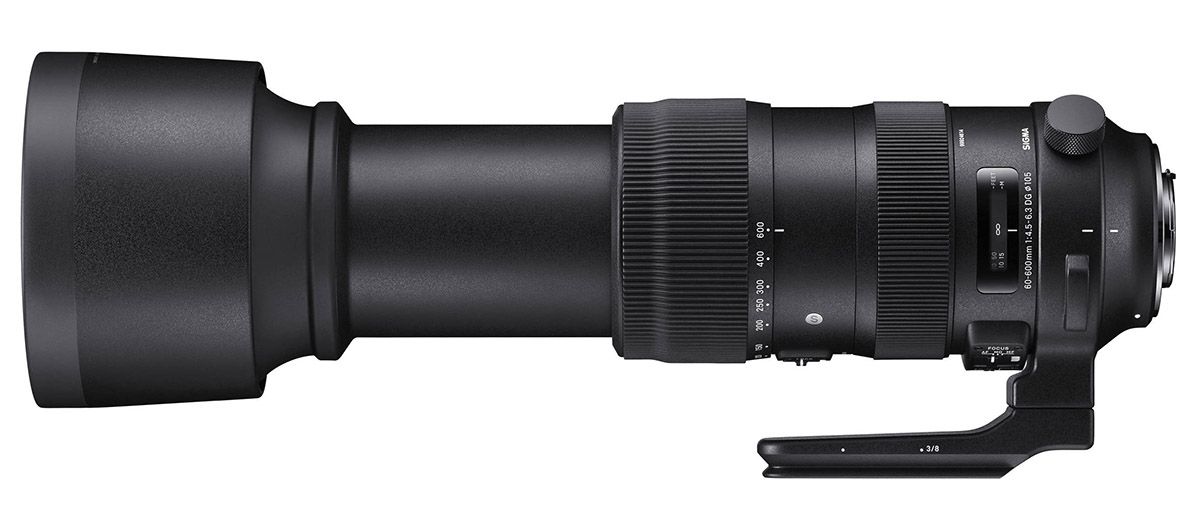
In the actual Sigma’s offer you can observe a transition toward 60-600mm and 150-600mm models and in the case of the latter we have two devices, one Contemporary and one Sport.
Overall this segment has been developing in leaps and bounds because also other players like Tamron (two versions of the 150-600 mm model) and Nikon ( the 200–500 mm model, tested by us not so long ago) offer their own devices. As you see, it’s definitely worth checking how the new Sigma compares with its rivals and predecessors.
Specifications – Sigma 60-600mm f/4.5-6.3 DG OS HSM Review
| Manufacturer | Sigma |
|---|---|
| Model | S 60-600 mm f/4.5-6.3 DG OS HSM |
| Lens style | Telephoto zoom |
| Focal length | 60 – 600 mm |
| Maximum aperture | f/4.5 – 6.3 |
| Angle of view | 39.6 – 4.1 o |
| Closest focusing distance | 0.6 m |
| Maximum magnification | 1:3.3 |
| Minimum aperture | 32 |
| Number of diaphragm blades | 9 |
| Auto focus type | HSM |
| Lens Construction | 25 elements / 19 groups |
| Filter diameter | 105 mm |
| Macro | No |
| Available mounts | Canon EF Nikon F Sigma |
| Dimensions | 268.9 x 120.4 mm |
| Weight | 2700 g |
| Additional information | Announced: 25.09.2018 3 FLD elements, 1 SLD element |
Build quality and image stabilization – Sigma 60-600mm f/4.5-6.3 DG OS HSM Review
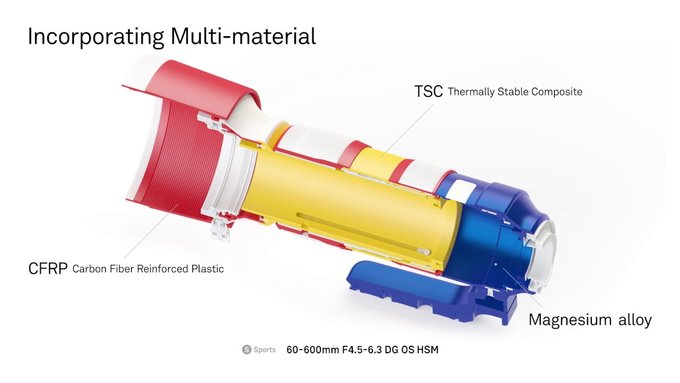
The proper tube of the lens is made of metal. It starts with a smooth ring which increases its diameter and on that ring you can find a white dot, making an alignment with a camera easier, and the 018 number marking the production year.
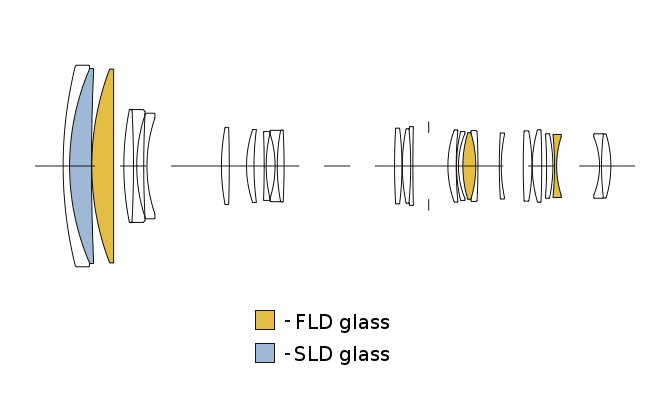
The next part is a very solid, adjustable tripod collar (you can change its angle) but, unfortunately, it can’t be completely detached from the body of the lens. It’s a pity. Sometimes you have to walk kilometres with such a lens, without either a tripod or a monopod. If you could leave the significantly big tripod collar behind the whole device would be much lighter and easier to handle.
Moving further on along the tube of the lens you find an inscription with the name and parameters of the instrument over which there is a window with a distance scale expressed in feet and meters. On its left side you see a whole series of switches. The first of them, FOCUS , allows you to choose the focusing mechanism mode from three possible options: AF, MO and MF. Apart from standard positions (manual focus ring remains active even after switching the lens to AF) you get also the MO (Manual Override) option; it means you can switch to MF by rotating the focus ring even during continuous AF. The next switch allows you to limit the autofocus range and you get three autofocus limiter positions: FULL, from 6 meters to infinity and from the minimum focusing distance to 6 meters. Then you see an OS switch which controls the optical stabilization unit (modes 1, 2 and OFF) and finally the last switch, labeled as CUSTOM , with three positions, OFF, C1, and C2. They allow you to choose focusing mechanism modes saved previously after calibrating the lens with the help of the Sigma USB Dock.
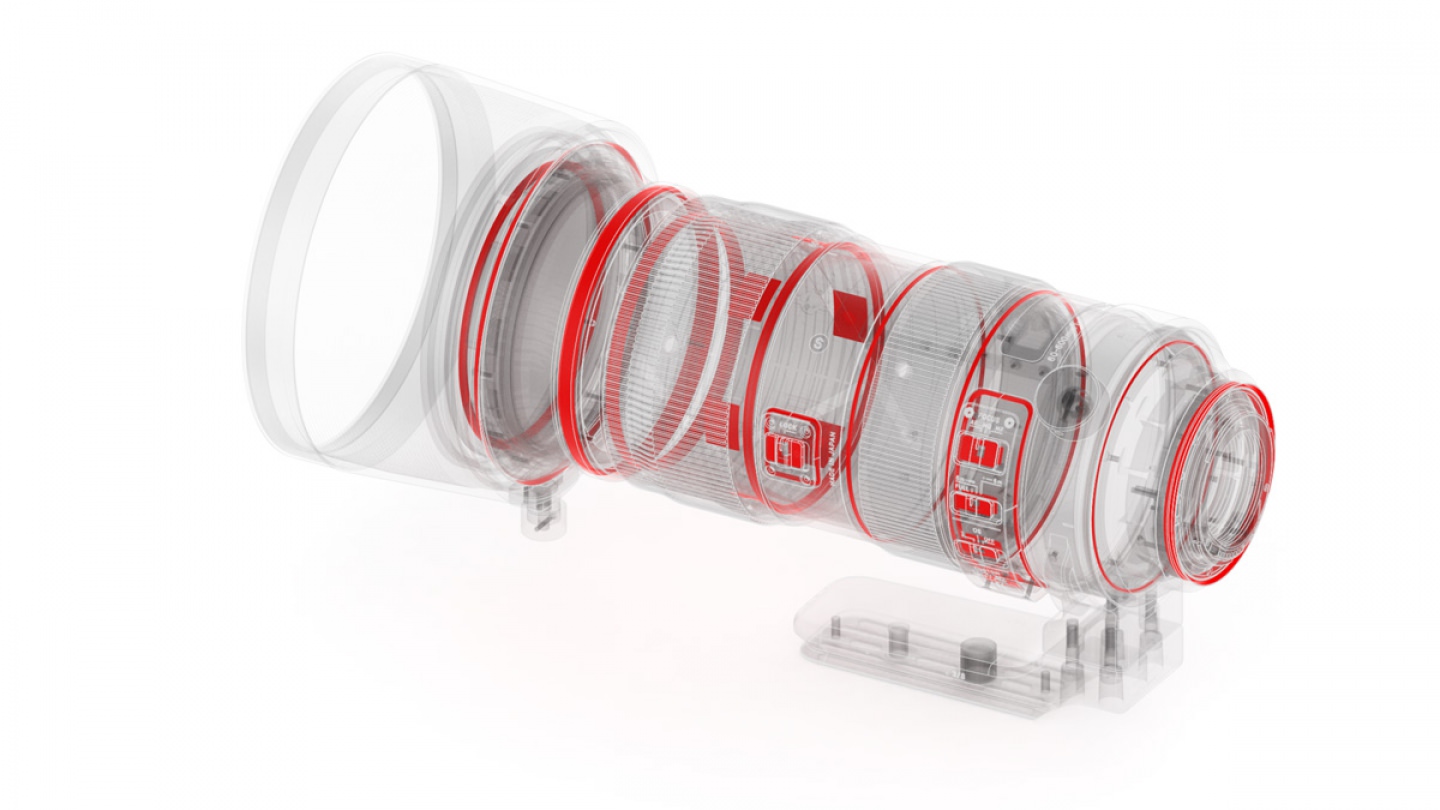
Further on there is a big manual focus ring, as wide as 38 mm. It is covered by ribs, allows you a very firm, comfortable grip. What’s more, it turns evenly and with very good precision. Running through the whole distance scale needs a turn through an angle of almost 160 degrees.
Then you see an immobile part of the casing with an ‘S’ letter meaning the lens belongs to the ‘Sport’ series, an inscription ‘MADE IN JAPAN’ and a LOCK switch which can be set to block the lens at all marked focal lengths, not only one. The fact that you don’t have to touch the switch with your finger in order to free the focal length is a very useful functionality; it’s enough you move the ring more vigorously and the switch releases the blockade on its own – an ingenious and useful solution in our opinion.
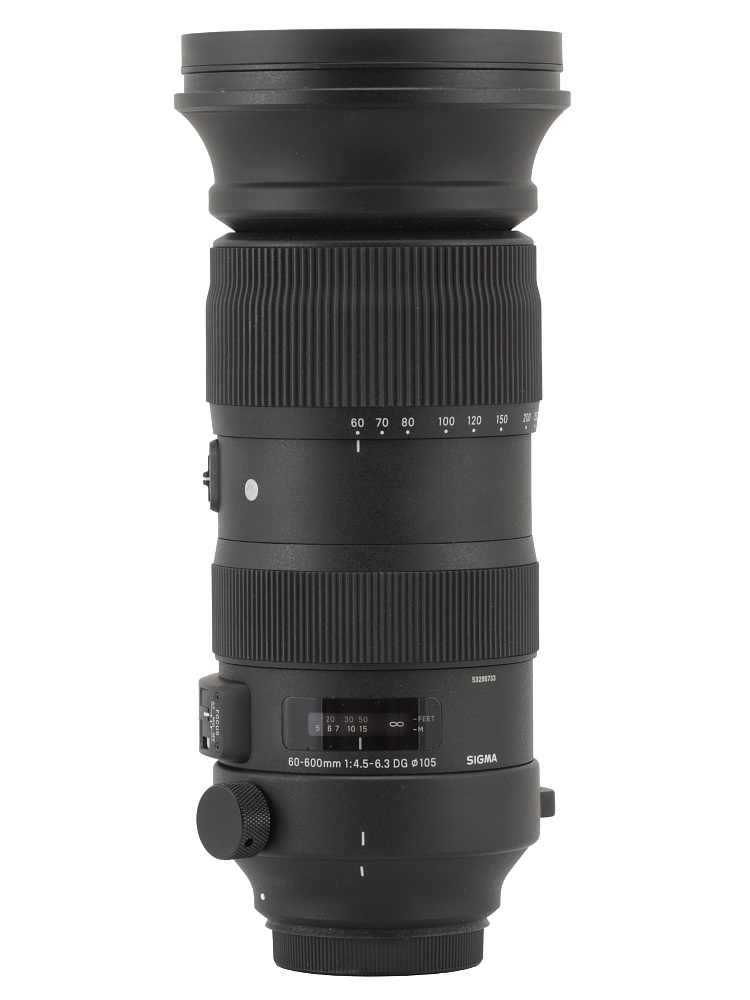
A zoom ring, as wide as 63 mm, is the next part of the lens. Most of its surface is covered by simple, comfortable, rubber ribbing under which you see focal length markings at 60, 70, 80, 100, 120, 150, 200, 250, 300, 400 and 600 mm. It’s worth noticing that the distance between 400 mm and 600 mm is very short and most likely that’s why there is no 500 mm focal length marking at all.
The rest of the lens consists of a part of the barrel which increases its diameter and houses the front element system. That part extends with the increase of the focal length on an uniform, very solid tube; that way the lens becomes by 10 cm longer at its maximum position.
The front element is 92 mm in diameter and just slightly hidden inside the tube; it is surrounded by a non-rotating filter thread, 105 mm in diameter. The lens doesn’t have a typical mount hood because the hood is attached with a special locking knob.
The producer emphasizes the fact that, in order to reduce the weight of the instrument, they incorporated multi-material such as magnesium composites, thermally stable composite (TSC), and carbon fibre reinforced plastic. The barrel also features special sealing and forefront and rear elements incorporate water and oil-repellent coating.
When it comes to optical construction you deal here with 25 elements positioned in 19 groups. The producer declares that among them you can find three FLD elements (F low dispersion) with properties of fluorite and one made of SLD glass. Inside you can also find a round aperture with nine blades which can be closed down to a value from f/22 to f/32, depending on the focal length.
Buyers get in the box: a hard case with a special shoulder strap, a hood with a cloth cap, a lens strap, and both plastic caps. It is a nice thing that, apart from the cloth cap, you also get the front plastic one. Not everybody wants to walk around with a hood and be forced to use its cloth cap.
Optical stabilization
Sigma declare that the efficiency of the optical stabilization system of the tested lens is supposed to amount to 4 EV. In order to check that claim we took several dozen photos at 600 mm with shutter speeds ranging from 1/640 to 1/10 of a second with the stabilization switched on and off. Then we calculated the percentage of blurred photos at every speed and presented the results as exposure time function graph, expressed in EV (with 0 EV being the equivalent of 1/500 of a second) which can be found below.
The maximum distance between both curves reaches 3.7- 3.8 EV and so we assess the stabilization efficiency. The result is perhaps a tad lower than declared (but completely in accordance with the given value within the margin of error) and we think it’s still good enough to allow you comfortable shooting at such long focal lengths.
Image resolution – Sigma 60-600mm f/4.5-6.3 DG OS HSM Review
At the beginning I would like to add that I tested the Sigma at six different focal lengths and it was deliberate. I actively looked for a weak point. After all it is a common flaw of hyper telephoto zooms with a high zoom ratio. Meanwhile the Sigma surprised me very nicely because it didn’t show any weaknesses in the frame centre. Not only its results are more coherent than the results of the Sigma 150-600mm but, what’s even more surprising, at the longer end of the focal spectrum the newer model fares actually better. Especially the 600 mm performance of the new Bigma should be praised; at this point the tested lens fares distinctly better than all 150-600 mm lenses tested by us so far. It also outperforms the Nikkor 200-500 mm at the 500 mm focal length.
Chromatic and spherical aberration – Sigma 60-600mm f/4.5-6.3 DG OS HSM Review
Chromatic aberration
Sigma S 60–600 mm doesn’t have any problems with correcting longitudinal chromatic aberration. At 200 and 600 mm focal lengths you can’t spot any traces of it and at 400 mm it is only slightly noticeable because blurry areas are slightly tinted. Still the problem is not big or even moderate so the performance of the lens should be assessed positively.
Spherical aberration
First images of this chapter don’t feature any ‘focus shift’ effect at any presented focal length. Circles of light we got before and after the focus aren’t perhaps completely identical but the differences between them aren’t pronounced, concerning mainly the intensity of the rim. You can say the tested Sigma doesn’t have any noticeable problems related to spherical aberration.
Distortion – Sigma 60-600mm f/4.5-6.3 DG OS HSM Review
While testing a telephoto lens you don’t expect any noticeable distortion problems. On the other hand the zoom ratio of this hyper-telephoto Sigma (10x) is so high that the task before the optics constructors could hardly be called easy.
If you focus on the smaller APS-C/DX sensor the distortion problems seem practically imperceptible. The results we got at 60, 100, 200, 300, 400 and 600 mm are as follows: -0.75%, -0.03%, +0.20%, +0.24%, +0.28%, +0.30%. In the 100-600 mm range you don’t have the smallest chances to notice any deformations because all of them amount to, within the margin of error, zero. If you look carefully only the 60 mm focal length shows some slightly noticeable barrel distortion.
On full frame the 60 mm focal length again fares the worst with a result of -1.77%, quite high for a telephoto lens. Overall, though, when it comes to absolute terms all these values are lower than 2% and they should be considered just moderate.
Autofocus – Sigma 60-600mm f/4.5-6.3 DG OS HSM Review
By the way I think that, with such a focal range, configuration possibilities, and the price of the offered lens, Sigma should think about adding the USB Dock device to the accessory kit.
What’s more, the lens we took our sample shots with performed very well at any focal length and at any distance without even the slightest calibration done either through the USB Dock or the microcalibration in the camera body.
In order to keep the balance we have to add that its performance is not as excellent and steady as the performance of autofocus units featured by expensive, top-of-the-range 2.8/400, 4/500 or 4/600 primes. Still for a lens aimed at amateur photographers which costs a fraction of the price of the aforementioned primes it fared really well and should be assessed very positively indeed.
Sample Images – Sigma 60-600mm f/4.5-6.3 DG OS HSM Review








Conclusion – Sigma 60-600mm f/4.5-6.3 DG OS HSM Review
Pros:
- very solid, weather-sealed casing,
- excellent image quality in the frame centre across the whole range of apertures and focal lengths,
- good performance on edge of APS-C/DX sensor,
- completely acceptable resolution on edge of full frame,
- low longitudinal chromatic aberration,
- lack of problems with lateral chromatic aberration in the 100 – 600 mm range,
- no reservations concerning spherical aberration correction,
- moderate distortion,
- good coma correction,
- imperceptible astigmatism,
- low vignetting on APS-C/DX sensor,
- blurry areas pleasing to the eye,
- efficient image stabilization,
- fast, efficient and silent autofocus.
Cons:
- distinct lateral chromatic aberration at 60 mm focal length,
- weak performance against bright light,
- high vignetting on full frame.
When Sigma launched two versions of the 150 -600 mm lens I would never guess they were going to present another generation of its older device commonly known as the ‘Bigma’. Even after hearing the first rumours concerning that instrument I still remained skeptical. I expected it would be even bigger and heavier (and of course more expensive) than the significantly heavy and big Sigma 150-600mm or its optical properties wouldn’t impress at all. Sigma proved once again that they are not afraid of challenges and the higher standards are raised the more mobilized they are. As a result we got a lens physically smaller and lighter than the Sigma 150-600 mm, sharper, and with a wider focal range too! In the comparable range, from 150 to 600 mm, the tested instrument was actually sharper than them and, overall, better in many aspects.
I think the tested Sigma will find many buyers and its excellent performance at the maximum focal length and, overall, throughout a wide range of useful focal lengths will make it a hit among photography fans who like capturing everything which flies.
